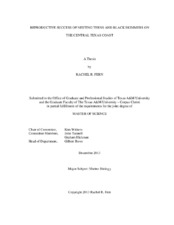| dc.description.abstract | Reproductive Success of Nesting Terns and Black Skimmers on the
Central Texas Coast (October, 2013)
Rachel R. Fern, B.S., Texas State University
M.S., Texas A&M University-Corpus Christi
Chair of Advisory Committee: Dr. Kim Withers
Seabirds are top predators at sea and are particularly sensitive to changes in the marine environment. This gives them significant potential as bioindicators of the current state of and shifts in marine ecosystems. Nest site selection is important because the demands of reproduction can be substantial and the reproducing pair is often confined to the area selected for the duration of the breeding season. Location of the nest in relation to vegetative cover, colony density and richness can strongly influence reproductive success via exposure to predators or weather events and competition for food resources and optimal nest sites. Additionally, the timing of nesting in the breeding season can influence the outcome of the breeding effort due to storm events and increasing ambient temperatures.
This study defines temporal effects and correlations between reproductive success of nesting terns and skimmers and environmental characteristics of the nest site: area (ha), vegetative coverage, Spartina spp. coverage, elevation, nest density, assemblage richness and human disturbance. The four species included in this research (Forster’s Tern Sterna forsteri, Gull-billed Tern Gelochelidon nilotica, Least Tern Sternula antillarum and Black Skimmer Rhynchops niger) were monitored at various nesting sites during the 2012 and 2013 breeding seasons. Reproductive success of Forster’s Terns seemed to be influenced by human disturbance, nest density and species richness of the nest site. Elevation and Spartina spp. coverage both positively influenced the success of Least Terns. The nesting success of Gull-billed Terns was positively correlated with elevation and species richness of the nest site, and success of Black Skimmers was negatively correlated with species richness and positively correlated with elevation. All species that nested early in the breeding season suffered nest failure due to storm events; however, Gull-billed Terns were only marginally impacted. Establishing these correlations in environmental nest site characteristics and reproductive success of nesting terns and skimmers provides a baseline understanding of tern and skimmer breeding biology in the central Coastal Bend region of Texas, which may assist future management decisions and restoration efforts. | en |


